Behaviour Recording: Uncovering the Function through analysis.
This page is slightly different from the usual articles on Inclusiveteach.com, behaviour recording represents the analytical element of Positive Behaviour Support, and represents the data collected when observation alone cannot ascertain the principal function of behaviour or when you want to track the effectiveness of a specific intervention or adaptation. eg you might want to change an aspect of your classroom environment and these records can help show the impact.
I maintain that building a relationship with the child/adult first and foremost is the most effective investment you can make. However, there are times when you need to analyse the behaviour further. The first step to uncovering the driver of behaviours of concern or the action that is having a negative impact on their quality of life is identifying the function of that behaviour. There are a number of ways we can start doing this. I am going to discuss and provide the tools I have found useful. Many books on the subject can be found here. I have found these books on the human aspects of behaviour much more useful in my approach.
All these resources are downloadable for free but if you click on these links I make a tiny bit of money to help with the hosting costs. I would especially value a facebook, twitter or Pinterest share.
I want to stress this should form part of a cohesive profile of behavioural presentation including input from parents, carers, family and the child themselves if appropriate. Diet and sleep are an important element in behaviour especially when triggers to behaviour are unclear. Below is a link to our page with a free food and mood chart.
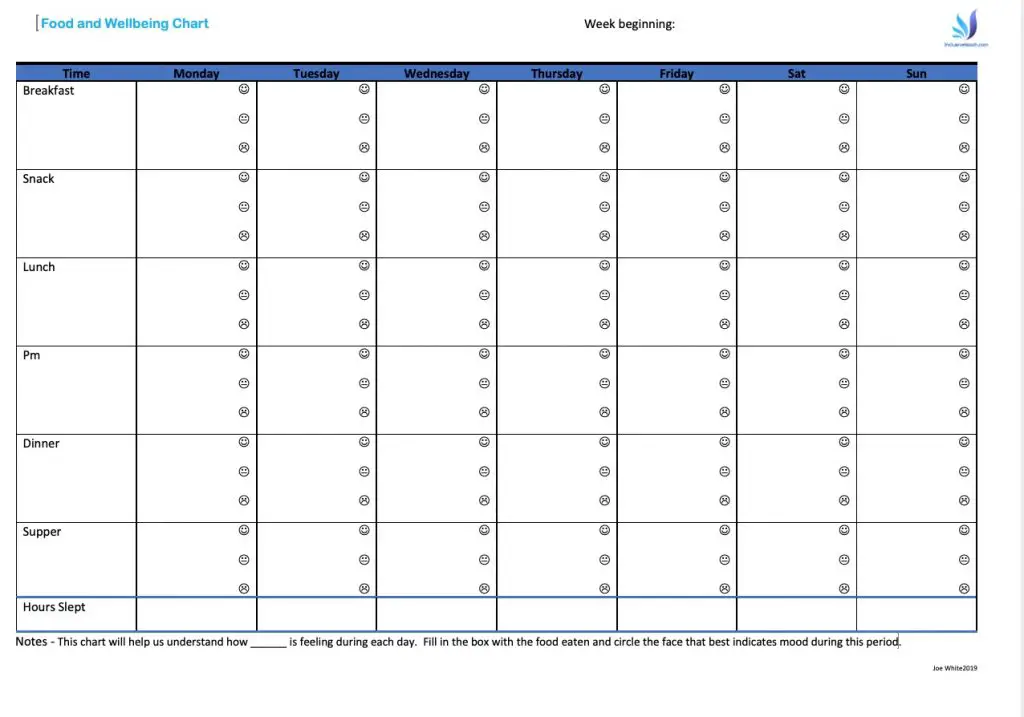
Behaviour Recording: Observation-based functional assessment.
The simplest is by observation, there are many ways to do this. A simple ABC chart that many of you will already be using can give you the first clues as to the cause of the behaviour and effective strategies for de-escalating. Initially, you want to be looking to see if you think the child is trying to gain something or escape from (or to) somewhere. Functions of behaviour and ABA are closely linked. We are moving away from this and into relational approaches. However a lot of agencies use this to support young people so it is worth knowing.
Then there is a more formal observation, may be asked for by a teacher is they want a pair of fresh eyes on a situation. I have developed this form that links to the function of behaviour sheet. This is subjective and provides an element of formality to the process. The behaviour support team can add their ideas or recommendations. It might even be worth the teacher taking a step back to observe their own student while someone else leads.
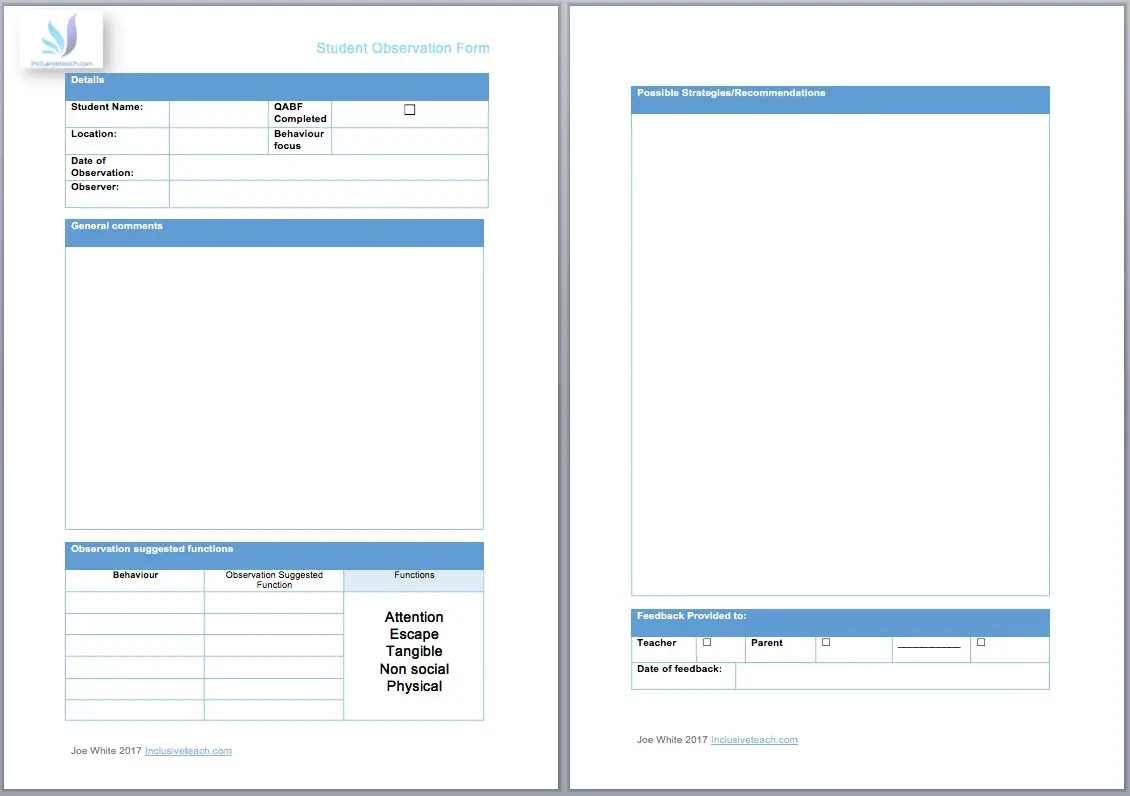
Download a paper-based student behaviour observation form here.
Download a digital student behaviour observation form here.
Questions about behaviour function
If you want to look into the function further it may be helpful to use Questions about behaviour function form (QABF). There are however other ways of determining and analysing the function of behaviour.
Download the QABF form as a free PDF here.
The function of the specific behaviour is what drives people behave in a certain way. Many factors determine why that behaviour becomes linked to a specific driver. These may not be obvious on initial observation. So a QABF sheet can be used to more accurately identify the function. A QABF should be completed individually by those who work with the student for one specific behaviour displayed in that particular environment.
Available data would suggest that the QABF provides a psychometrically robust tool that can be used to develop effective interventions for individuals who display behaviours of concern.
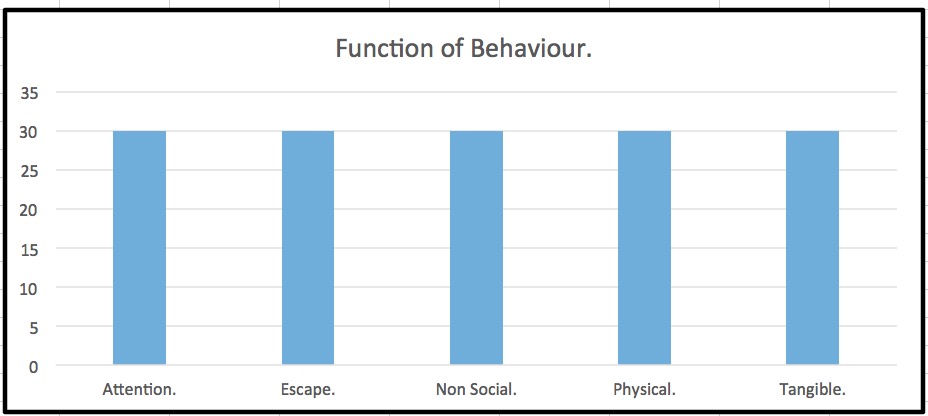
Data shows that interventions and strategies to focus based on QABF-identified functions were more effective than were treatments not based on QABF-identified functions. The QABF identified a clear function in 84% of cases. However, there may be more than 1 function for each behaviour and multiple behaviours that meet the same function.
From using this extensively I think that it tends to overemphasis the attention function. So we now use it in conjunction with analysis of ABC chart data and staff observations.
The QABF examines 5 functions:
* Escape. The individual behaves in order to get out of doing something he/she does not want to do. This may also be to avoid a situation, task, environment or person
* Attention: The individual behaves to get focused attention from parents, teachers, siblings, peers, or other people that are around them.
* Tangibles: Individual behaves in order to get a preferred item or participate in an enjoyable activity.
* Sensory Stimulation: The individual behaves in a specific way because it feels good to them. This may also be an attempt to regulate environmental stimuli – noise, light, smell, proprioception
* Non-Social: The individual behaviour occurs automatically even when they are alone, for self-stimulation, no social input is desired.
Once the QABF has been completed hopefully a primary function has been identified, a hypothesis can be generated. If appropriate this hypothesis can be tested either through a carefully managed challenge or making adaptations to the environment, activities, demands or approach. This has been proved particularly effective in reducing incidents of aggressive behaviours.
To begin addressing behaviours of concern new skills or strategies may need to be taught including but not limited to communication techniques, calming techniques or exit strategies.
Monitoring Challenging Behaviour for Functional Behaviour Analysis
Establishing a baseline level for behaviour is important prior to trailing any interventions. One of the ways to do this is to monitor the duration of the behaviour throughout the day. This sheet won’t capture any ABC but will give you an idea of the level of disruption to learning or progress that the behaviour has. You colour a block for each minute that behaviour is displayed across that day. This way you end up with a bar chart style representation of the data. A good place to start a discussion. You can also use this to monitor the effectiveness of any intervention you are trying. I think it is important to give anything at least two weeks to embed but you might want to delete some boxes. 30 minutes may also be too much.
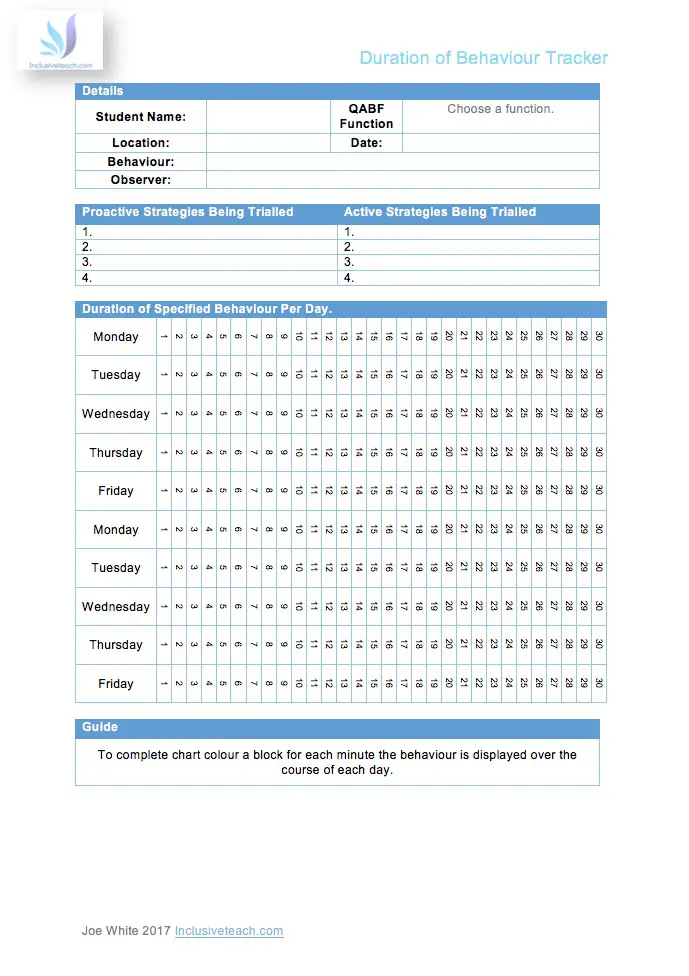
Download the Duration of Behaviour Incident Form Here
Behaviour Intervention Strategy Effectiveness Form.
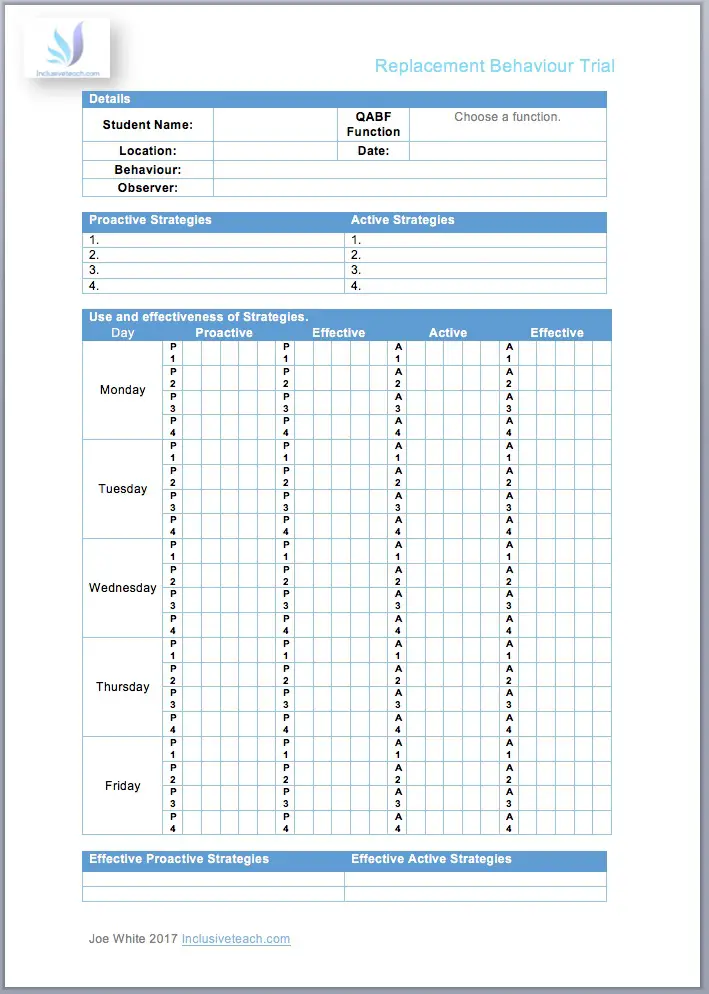
We talk a lot about Proactive and Active strategies in the training I deliver but usually don’t systematically assess the impact of each individual strategy. This form allows you to record, track and then analyse the use of four different Proactive and Active (your planned response to the behaviour). You tick a box every time you use a strategy and tick the next box every time this is effective. You can then see which interventions to continue with and which to adapt.
Download the Proactive/Active Replacement Behaviour Form Here
Engagement Levels and SEND learners.
Anyone working in special educational needs will by now have heard of the Rochford review that looks at the place of P-Levels with our students. It notes the importance of engagement. This is also true when students display challenging behaviour, are they engaged or even ready to learn?
Download the student engagement tracker here.
Throughout the day it is easy to lose track of what exactly you are doing that works or doesn’t when getting a student engaged in an activity. This simple tracker lets you note the time and activity and whether the student engaged or not. It then asks you to record any negative behaviours displayed so you can add them to a behaviour support plan. I added a box to capture what you did that was effective – this information is invaluable. Again you will need to complete it a few times to start building a picture or to identify patterns – engages more after lunch etc.
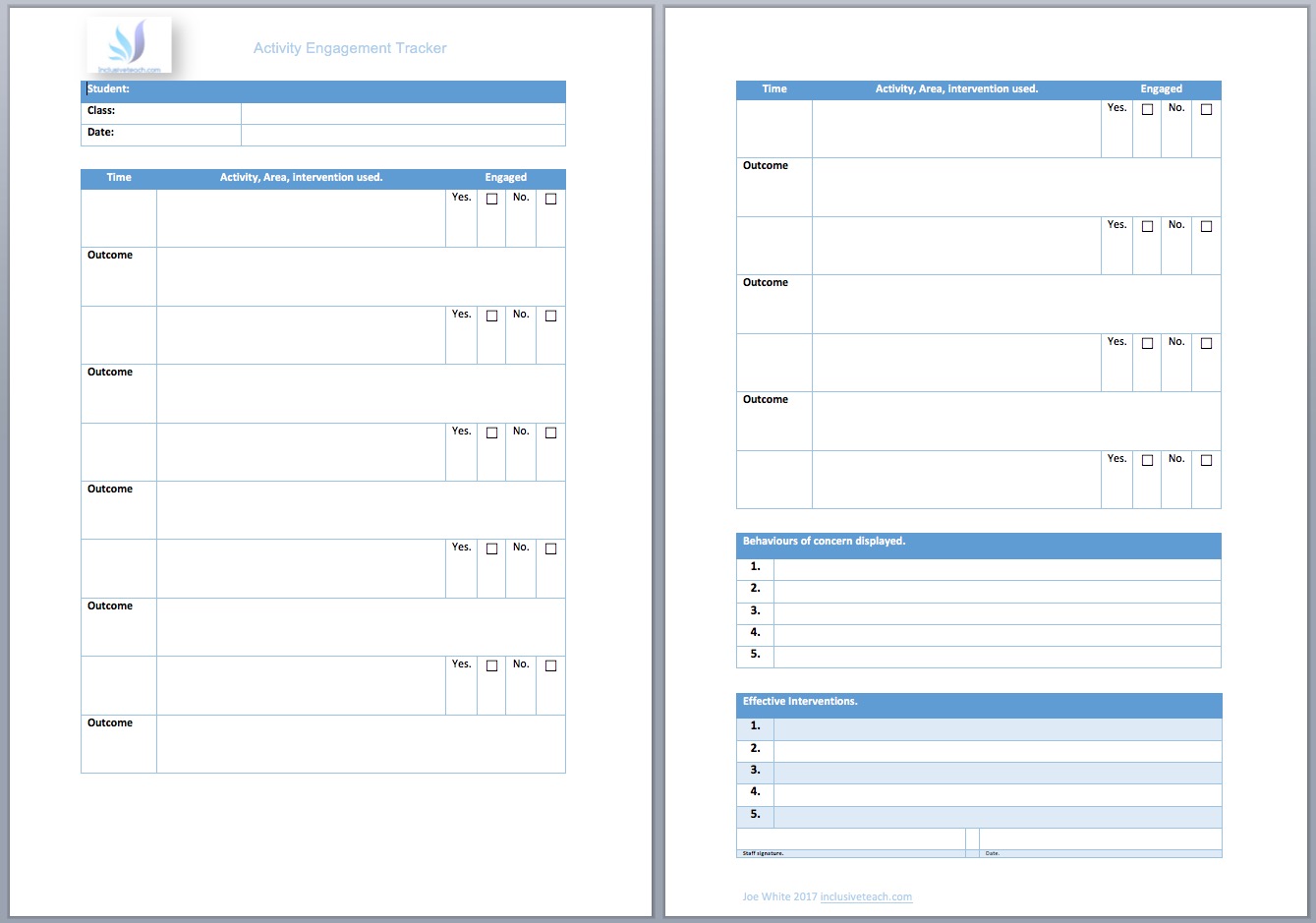
Recording and Analysing Challenging Behaviour Data
This is a basic behaviour frequency analysis software that Inclusiveteach.com offer for your use free of charge. However, we would ask that you don’t sell or reproduce this. If you have found it helpful please share this site widely!
Any data collected is meaningless until you review it. This data analysis spreadsheet (excel) looks at the frequency of your chosen behaviours by day over a time period of 12 weeks. (Two UK academic terms).
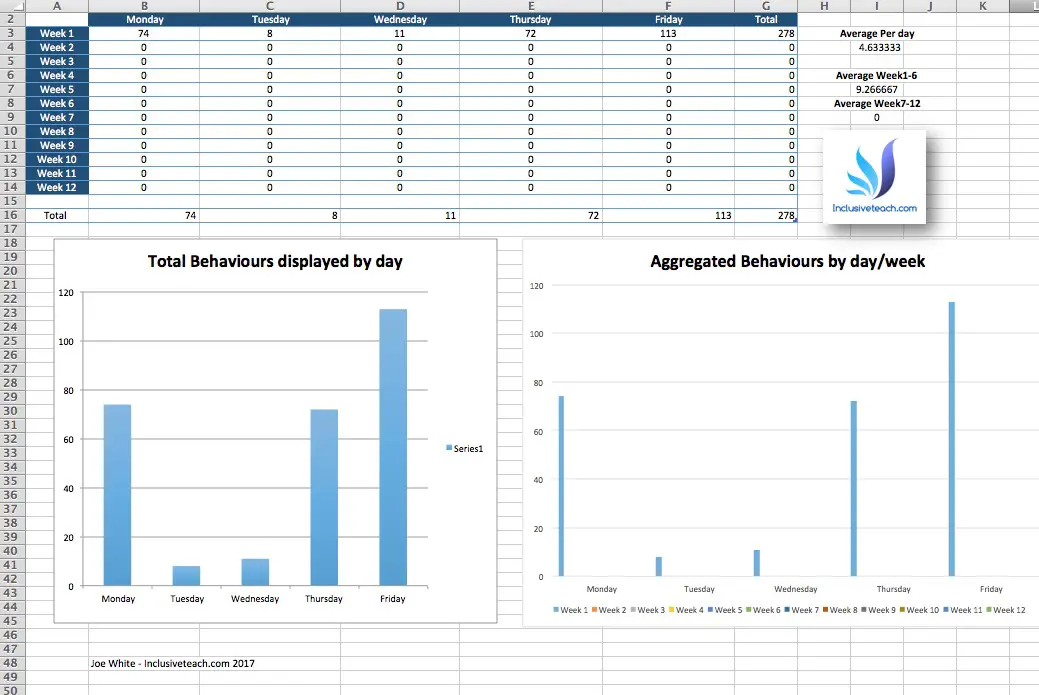
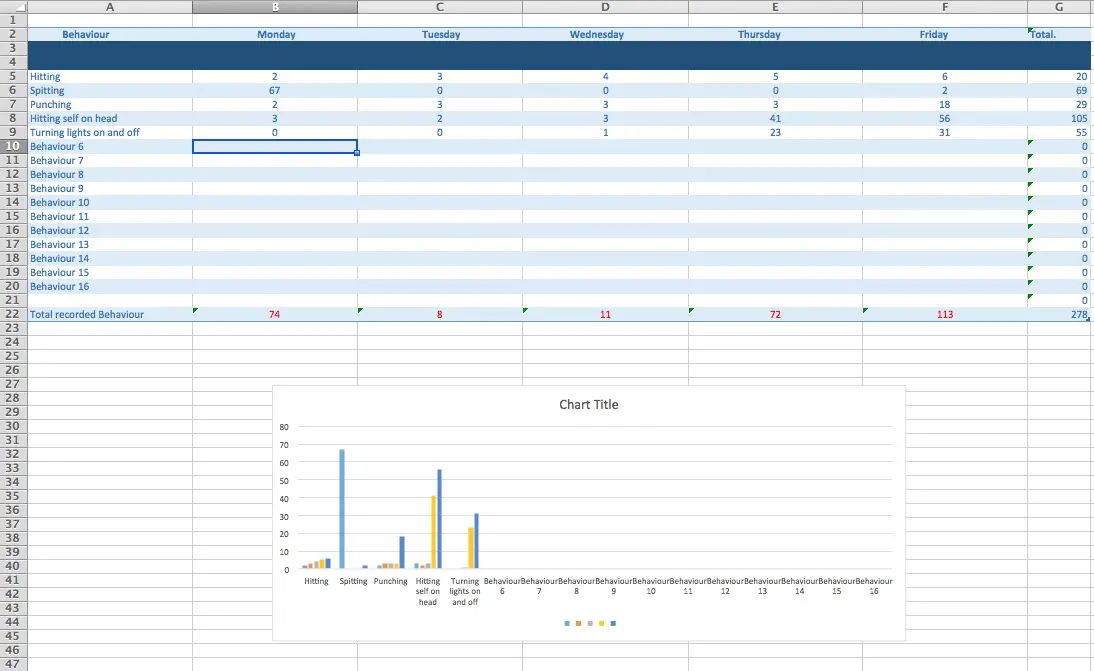
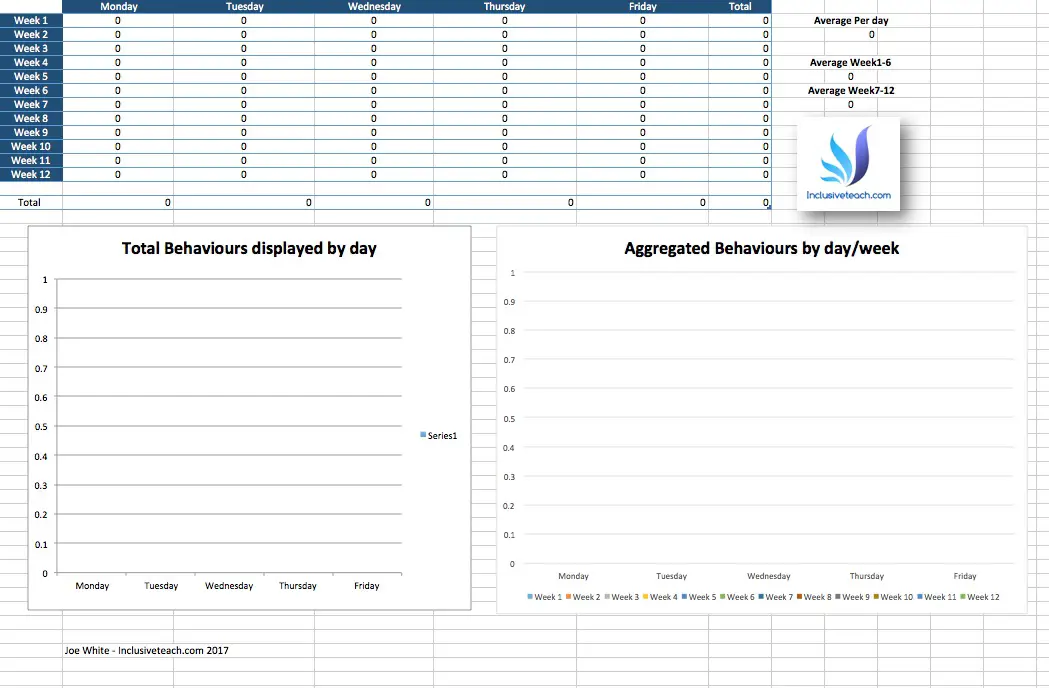
The front sheet automatically charts the totals for you. So you can look at which days are the most challenging for the child. Click on the week pages at the bottom to enter the data for each week (total per day) you can change the behaviour to hitting, spitting etc whatever you are tracking.
Download the free Daily/Weekly behaviour frequency spreadsheet here.
Hourly Behaviour Recording Chart
Here is the hourly version again with multiple weeks for tracking over longer time periods runs from 8am-midnight but you can add more if needed. Also includes a cool average formula so you can see the average for morning, afternoon and evening if need be. The front 2 sheets all add up the data which is entered by week.
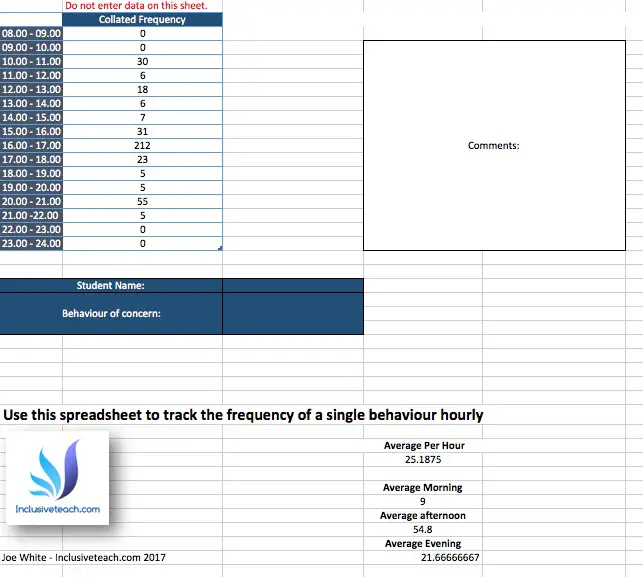
Download the free hourly Behaviour_Record_Chart Here.
I hope you find these behaviour recording documents helpful. Feel free to add a comment if you would like anything else.
References.
Singh, N. et al (2006) Questions About Behavioral Function in Mental Illness (QABF-MI) A Behavior Checklist for Functional Assessment of Maladaptive Behavior Exhibited by Individuals With Mental Illness accessed online
Matson, J.L. (2012) Functional Assessment for Challenging Behaviors.
Matson, J. L., Bamburg, J. W., Cherry, K. E., & Paclawskyj, T. R. (1999). A validity study on the Questions About Behavioral Function (QABF) scale: Predicting treatment success for self-injury, aggression, and stereotypes. Research in Developmental Disabilities, 20, 163-176.
Johannes Rojahn a, *, Rebecca H. Zaja a , Nicole Turygin a , Linda Moore b , Daniel J. van Ingen b (2012) Functions of maladaptive behavior in intellectual and developmental disabilities: Behavior categories and topographies. Accessed online
Terminology Linked to Behavior support:
ABA, Functional analysis, Applied behaviour analysis, positive behaviour support, challenge, concern, Functional assessment of challenging behaviours.

You must be logged in to post a comment.